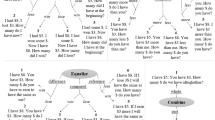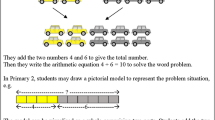Abstract
Whole number arithmetic is the foundation of higher mathematics and a core part of elementary mathematics. Awareness of pattern and underlying problem structure promote the learning of whole number arithmetic. A growing consensus has emerged on the necessity to provide students with the opportunity to engage in algebraic reasoning earlier in their education. In fact, the U.S. National Council of Teachers of Mathematics curriculum standards and the nationwide mathematics reform call for algebra readiness in elementary mathematical learning. The purpose of this study was to evaluate the effect of Conceptual Model-based Problem Solving (Xin, Conceptual model-based problem solving: Teach students with learning difficulties to solve math problems. The Netherlands: Sense Publishers, 2012) intervention program, with the Singapore bar model method (Kaur, The model method—A tool for representing and visualising relationships, In: Conference proceedings of ICMI study 23: Primary mathematics study on whole numbers, pp 448–455, 2015) serving as the bridge towards symbolic mathematical model equations, on enhancing additive word problem-solving performance of elementary students who are struggling in mathematics. Findings from this study indicate the promise of this program. Through representing a range of additive word problem situations in one cohesive mathematical model equation, students are prepared for generalized problem-solving skills.



Similar content being viewed by others
References
Blomhøj, M. (2004). Mathematical modelling—A theory for practice. In B. Clarke et al. (Eds.), International perspectives on learning and teaching mathematics (pp. 145–159). Göteborg: National Center for Mathematics Education.
Bruner, J. S. (1973). Beyond the information given: Studies in the psychology of knowing. Oxford: W.W. Norton.
Bryant, D. P., Bryant, B. R., Roberts, G., Vaughn, S., Pfannenstiel, K. H., Porterfield, J., & Gersten, R. (2011). Early numeracy intervention program for first-grade students with mathematics difficulties. Exceptional Children, 78(1), 7–23.
Carraher, D. W., Schliemann, A. D., Brizuela, B. M., & Earnest, D. (2006). Arithmetic and algebra in early mathematics education. Journal for Research in Mathematics Education, 37, 87–115.
Carpenter, T. P., Fennema, E., Franke, M., Levi, L., & Empson, S. B. (1999). Children’s mathematics: Cognitively Guided Instruction. Portsmouth, NH: Heinemann.
Carpenter, T. P., Levi, L., Franke, M., & Zeringue, J. (2005). Algebra in the elementary school: Developing rational thinking. ZDM, 37(1), 53–59.
Chappell, M. F., & Strutchens, M. E. (2001). Creating connections: Promoting algebraic thinking with concrete models. Mathematics Teaching in the Middle School, 7(1), 20–25.
Common Core State Standards Initiative (2012). Common core state standards for mathematics practice. http://www.corestandards.org. Accessed 15 Mar 2018
Connolly, A. J. (1998). Keymath revised/normative update. Circle Pines: American Guidance Service.
Devlin, K. (2012). Introduction to mathematical thinking. Palo Alto, CA: Keith Devlin.
Fede, J. j., Pierce, M. E., Matthews, W. J., & Wells, C. S. (2013). The effects of a computer-assisted, schema-based instruction intervention on word problem-solving skills of low-performing fifth grade students. Journal of Special Education Technology, 28(1), 9–21.
Fuchs, L. S., Fuchs, D., & Hollenbeck, K. N. (2007). Expanding responsiveness to intervention to mathematics at first and third grade. Learning Disabilities Research and Practice, 22, 13–24.
Greer, B. (1992). Multiplication and division as models of situations. In D. Grouws (Ed.), Handbook of research on mathematics teaching and learning (pp. 276–295). New York: MacMillan.
Hord, C., & Xin, Y. P. (2013). Intervention research for helping elementary school students with math learning difficulties understand and solve word problems: 1996–2010. Learning Disabilities: A Multidisciplinary Journal, 19(1), 3–17.
Horner, R. D., & Baer, D. M. (1978). Multi-probe technique: A variation of the multiple baseline. Journal of Applied Behavior Analysis, 11, 189–196.
Jitendra, A. (2002). Teaching students math problem-solving through graphic representations. Teaching Exceptional Children, 34(4), 34–38.
Jonassen, D. H. (2003). Designing research-based instruction for story problems. Educational Psychology Review, 15(3), 267–296.
Kaur, B. (2015). The model method—A tool for representing and visualising relationships. In Sun, X., Kaur, B. & Novotna, J. (Eds.) Conference proceedings of ICMI study 23: Primary mathematics study on whole numbers (pp. 448–455). Macau, Macao SAR: University of Macau.
Kazdin, A. E. (1982). Single-case research designs: Methods for clinical and applied settings. New York: Oxford.
Kratochwill, T. R., & Williams, B. L. (1988). Perspective on pitfalls and hassles in single-subject research. Journal of the Association for Persons with severe Handicaps, 13, 147–154.
Maletsky, E. M., et al. (2004). Harcourt math (Indiana edition). Chicago: Harcourt.
Marshall, S. P. (1995). Schemas in problem solving. New York: Cambridge University Press.
Mulligan, J., & Woolcott, G. (2016). What lies beneath? Conceptual connectivity underlying whole number arithmetic. In Sun, X., Kaur, B., & Novotna, J. (Eds.) Conference proceedings of ICMI study 23: Primary mathematics study on whole numbers (pp. 220–228). Macau, Macao SAR: University of Macau.
National Assessment of Educational Progress Result (NEAP) (2015). http://www.nationsreportcard.gov/reading_math_2015/#mathematics/acl?grade=4. Accessed 15 Mar 2018
National Governors Association Center for Best Practices and Council of Chief State School Officers (2010). Common core state standards for mathematics. Washington, DC: National Governors Association Center for Best Practices and Council of Chief State School Officers.
Nunes, T., Dorneles, B. V., Lin, P.-J., & Rathgeb-Schnierer, E. (2016). Teaching and learning about whole numbers in primary school. Dordrecht: Springer International Publishing.
Scruggs, T. E., & Mastropieri, M. A. (1998). Summarizing single subject research: Issues and applications. Behavior Modification, 22, 221–242.
Sherin, M. G. (2001). Developing a professional vision of classroom events. In T. Wood, B. S. Nelson & J. Warfield (Eds.), Beyond classical pedagogy: Teaching elementary school mathematics (pp. 75–93). Hillsdale: Erlbaum.
Snyder, T. (2005). GO Solve word problems: Using graphic organizers to understand and solve word problems. Position statement. Watertown: Tom Snyder Productions.
Sowder, L. (1988). Children’s solutions of story problems. Journal of Mathematical Behavior, 7, 227–238.
Thompson, P. W. (1989). Artificial intelligence, advanced technology, and learning and teaching algebra. Research Issues in the Learning and Teaching of Algebra, 135–161.
Vergnaud, G. (1979). The acquisition of arithmetical concepts. Educational Studies in Mathematics, 10, 263–274.
Williams, K. T. (2004). GMADE Group mathematics assessment and diagnostic evaluation. Assessment and diagnostic evaluation. Technical manual. Circe Pines: AGS Publishing.
Xin, Y. P. (2007). Word-problem-solving tasks presented in textbooks and their relation to student performance: A cross-curriculum comparison case study. The Journal of Educational Research, 100, 347–359.
Xin, Y. P. (2012). Conceptual model-based problem solving: Teach students with learning difficulties to solve math problems. The Netherlands: Sense Publishers.
Xin, Y. P., Liu, J., & Zheng, X. (2011a). A cross-cultural lesson comparison on teaching the connection between multiplication and division. School Science and Mathematics, 111(7), 354–367.
Xin, Y. P., & Zhang, D. (2009). Exploring a conceptual model-based approach to teaching situated word problems. The Journal of Educational Research, 102(6), 427–441.
Xin, Y. P., Zhang, D., Park, J. Y., Tom, K., Whipple, A., & Si, L. (2011b). A comparison of two mathematics problem-solving strategies: Facilitate algebra-readiness. The Journal of Educational Research, 104, 381–395.
Acknowledgements
The study reported in this paper was assisted by You Luo, a former graduate students at Purdue University. The author would like to thank the administrators, teachers, and students at Lafayette School Corporation who facilitated this study.
Author information
Authors and Affiliations
Corresponding author
Rights and permissions
About this article
Cite this article
Xin, Y.P. The effect of a conceptual model-based approach on ‘additive’ word problem solving of elementary students struggling in mathematics. ZDM Mathematics Education 51, 139–150 (2019). https://doi.org/10.1007/s11858-018-1002-9
Accepted:
Published:
Issue Date:
DOI: https://doi.org/10.1007/s11858-018-1002-9




